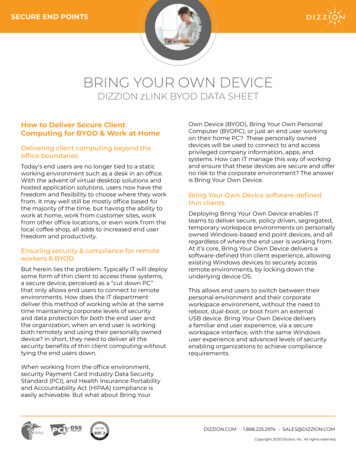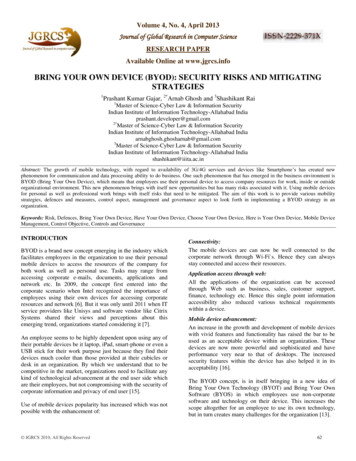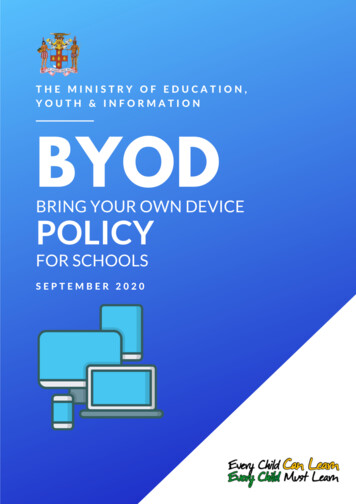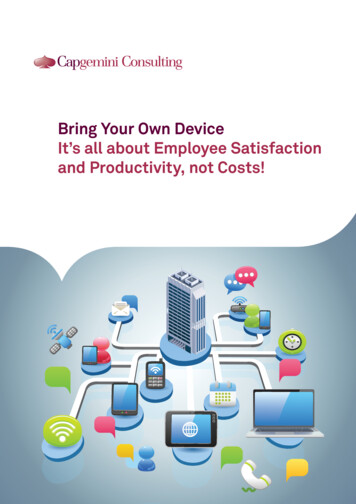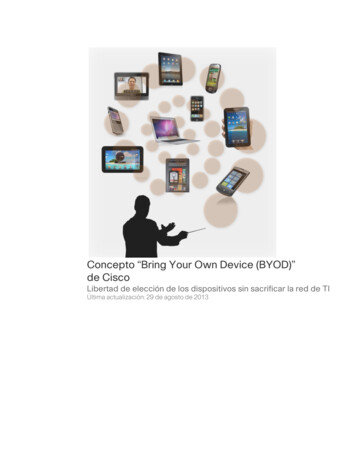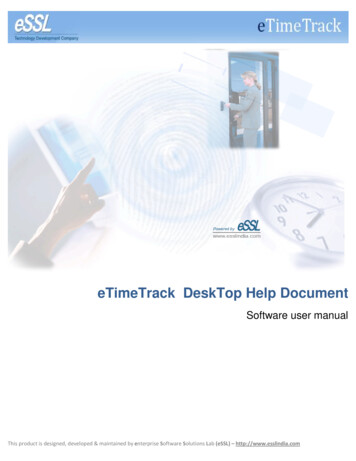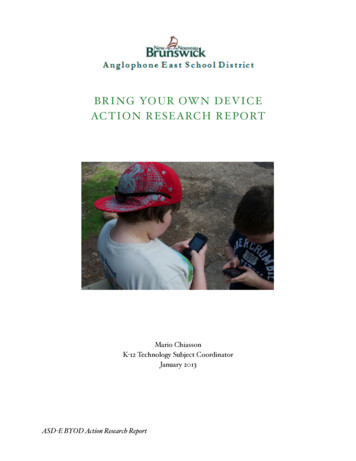
Transcription
B R I N G YO U R OW N D E V I C EAC TI O N R ES EA RC H R EP ORTMario ChiassonK-12 Technology Subject CoordinatorJanuary 2013ASD-E BYOD Action Research Report
Table of ContentBring Your Own Device!"3Overview Of The sroom Observations and Interviews"7Recommendations"9Conclusion"ASD-E BYOD Action Research Report"102
Bring Your Own Device!A two month action research!Overview Of The ResearchIn collaboration with the Department of Education and Tantramar Regional High School(TRHS), Anglophone School District - East has conducted action research to determine theimpact of the “Bring Your Own Device” (BYOD) project at TRHS.The purpose of this research study is twofold: to have a better understanding of the efficiency of the personal mobile device as an instructional tool and to develop a systematicprocess to allow schools to incorporate a BYOD program safely, as part of the school culture.Tantramar Regional High School is located in the small community of Sackville, NewBrunswick. This is a rural school with approximately 460 students and 33 teachers. One ofthe primary reasons for selecting TRHS to conduct this research study is because of the preexisting network infrastructure in place to support this initiative.IntroductionTo be globally competitive in the 21st century, students need to be critical thinkers and problem solvers with the ability to work and learn in teams while also being innovative, creative,and complex communicators. The use of Information and Communication Technology(ICT) tools certainly can contribute to the development of these skills. Research indicatesthat the evolution of ICT definitely has changed the way people communicate, collaborate,cooperate and from an education perspective, the ways students can learn. The use of videoconferencing to communicate, podcasts and blogs to publish, and collaborative platforms toshare resources has established an environment where students can be in control of theirlearning. ICT has resulted in a shift in the process of learning. Furthermore, it has createdsome questions about how, when and where students can learn.With the evolution of the ICT hardware, digital information can now can be access from ahandheld device. In 2008, Anglophone School District - East conducted a two year researchstudy on mobile learning. Data collected from this project indicated that 81% of students ingrade 6 to 12 had a cellphone and 36% of these students had a Smart Phone. Therefore it isfair to conclude that the BYOD program is a natural evolution of technology as a learningtool. This notion is building momentum in education systems around the world. ManyASD-E BYOD Action Research Report"3
school districts are currently researching the potential benefits and the inherent challengesof BYOD at schools.It is imperative to attain a solid understanding of the the impact of BYOD. There are twomajor areas that require closer examination: the classroom learning environment and thenetwork infrastructure.The first area of concentration is an environment of learning where students can use a personal device anytime and have access to unfiltered information. With the understandingthat the devices are not filtered, admittedly it is difficult to monitor specific student activities on the personal devices. Regardless of this obvious challenge the inclusion of these devices in the classroom offers increased instructional flexibility to teachers, provides studentsmore accessibility to electronic academic research information, and creates abundant opportunities for virtual collaboration and communication using ICT tools like the NBEDPortal, NBED Blogs, NBED Wikis, NBED e-mail and other electronic sources.The second focal point is the impact of personal devices on the network infrastructure ofschools. In 2003-04, the New Brunswick Department of Education invested a significantamount of resources in the schools’ network with the intent of providing internet connectivity to educational staff including school administrators, teachers, psychologists, custodians, and school administrative assistants. This layout is known as a “thin wireless” infrastructure. Only a few Access Points (AP) are installed in specific locations of the school tomake sure all school staff have access to the Internet. One of the potential challenges ishaving multiple devices connected to the school wireless network that overload the wirelessconnectivity and result in lost connection. The network layout is designed for a limitedamount of users; BYOD creates a broader perspective in terms of network infrastructurevolume.As indicated, the focus of the action research study is to achieve a better understanding ofthe impact of personal mobile devices as an instructional tool and the development of a systematic process to allow schools to incorporate a BYOD program as part of an effectivelearning culture in schools. The methodology, results, classroom observations, interviews,recommendation, and conclusion are contained in the following sections of this report.Before pursuing this topic, it would be important to clarify and understand what is an ICTtool. It is basically any device capable of receiving, processing and sending digital information wirelessly or physically connected. These tools can be a notebook, netbook, cell andsmart phones, gaming console, iPod, tablet like iPad and Playbook to name a few. All ofthese devices are part of the technology evolution.ASD-E BYOD Action Research Report"4
MethodologyThe action research was conducted during a five week period in May and June 2012. Aschool committee was formed by the school administrator and the district office personal todiscuss the layout and scope of the project. In consultation with school staff, four teachersvolunteered to participate in the research with their classes. With the four classes, a total of87 students were involved in the project. A letter was sent home to be signed, indicatingthat students were able to bring their own devices to school to support their learning. Asmentioned previously, those personal devices have the capability of connecting to the schoolwireless network.A survey was completed by grade 9 to 12 students to identify what personal mobile devicesthey possessed. Due to limited time only six hours of classroom observation was done;seven students and three teachers were interviewed. It is important to indicate that none ofthe teachers received any PD for this project. To provide support to teachers, one technology mentor was assigned full time for the first week and one technician was on standby incase of network connectivity issues.ResultsBased on the data collected, it is important to mention that a low participation of grade 12students (n 32) responded to the survey. Therefore, the grade 12 data representation on thefollowing chart is questionable.A. Chart 1: Student Survey (Student ICT Devices)Which%of%the%following%do%you%have?%(n e#ASD-E BYOD Action Research Report"iPod#Touch#Game#PlaEorm#Computer/Laptop#5
As anticipated, the chart indicates that the cell phone and the iPod touch are the handhelddevices that are well embedded in students’ personal lives. Actually one of the studentsthat was interviewed mentioned that it was exciting to be able to use his iPod touch for academic purposes and not get in trouble for using it. Another student indicated it was effective to use your own device because it was set to your personal need and you could work atmaximum efficiency.As for the smartphone, 29.5% of the student population own one. This is quite remarkable!It means that three students out of ten have a personal device where they can have access todigital information (Internet) to support their learning anytime and anywhere. It would beinteresting to know what their predominant activities are with these devices and how teachers could capitalize on these activities as a teaching strategy.What was quite revealing is that 61.3% of the population have an iPod. An iPod is a handheld device where students could have access to information using the wireless network atschool. Currently one of the major challenges that Anglophone East School District is experiencing is the lack of accessibility to ICT equipment and support at school. Knowingthat six students out of 10 own a device capable to access information, schools and districtshould be investing in wireless infrastructure and an equity plan for the students that do notown an ICT device.It is also fascinating to discover that 89.5% of the students have a gaming platform such asPS2, Playstation, and Wii to name a few that are at the high school level. Having said that,there are many research studies that are in the process of investigating how gaming platformstimulates the process of learning and how those 21 Century learning skills like collaboration, critical thinking and problems solving are developed.ASD-E BYOD Action Research Report"6
Classroom Observations and InterviewsA. Classroom ObservationWhen students realized that they were able to bring their own device to school, they wereexcited and considered themselves privileged to have this opportunity. They felt a sense ofresponsibility about their personal device to support their learning. It was also interesting toobserve that students were using and accessing multiple personal devices at the same time intheir classes. Some students engaged with as many as three devices; they were using each ofthem for different tasks.It was rare that students had technical issues because these devices were their own and ifthey did, they typically were able to solve the problem themselves or in consultation with apeer. The most common issue was losing wireless connectivity. By logging in again the problem was quickly solved. Interestingly, students were guarded with their handheld devicessuch as cell phones and Smart Phones (Blackberry and iPhone). They were more receptiveto sharing their notebooks (laptop, netbook and Macbook) in a similar manner to sharingpaper books.The most fascinating observation was that students accessed multiple applications to accomplish their work regardless of the software. For example, to create graphs, some students used Lotus 123, some used Numbers, others Microsoft Excel or Google Docs. It wasthe same with the writing process and media production activities. It would be interestingto find out how many software/licenses purchased by the the province are really needed.For printing and document storing, students sent their documents to the teacher to havethem printed as needed. Students had access to the Virtual Classroom provided by the Department of Education to upload and share documents. Online resources included Google,Wikipedia, and Youtube were the most used by the students. Equally noticeable was thatstudents were able to seamlessly transform their personal devices into a learning tool.At the beginning of each session teachers gave clear expectations and goals of the lessonplan or project. It was evident that the teachers were prepared for and comfortable withstudents accessing their own devices in their classrooms. From a class management perspective, there was an ongoing sense of mutual respect between teachers and students.ASD-E BYOD Action Research Report"7
B. InterviewsStudents InterviewsSeven students were interviewed individually for a period of 10 to 15 minutes. It was evidentthat these students were exited to use their personal device for academic purposes. Theywere confident in their ability to manipulate their devices which further enabled them toeffectively complete the assigned task. Additionally, the fact that they were able to start anactivity at school and finish it at home on the same device increased their efficiency withtask completion. They didn’t have to save work on a memory stick and load it on the homecomputer.All students indicated that they had more ownership on their personal device instead of thedevice provided by the education system. They felt an increased sense of control over theirdevice. The ability to personalize gave them a sense of productivity. Many of them mentioned that it took a certain amount of time for the computer to start up. Every time theyused the same computer it automatically reset because of a program call “Deepfreeze”.With their devices, they knew where their work was saved. Here is a video link that captures their perspective (http://www.youtube.com/watch?v OWzUVdIZ9mI).It is evident that students really appreciated and enjoyed using the personal devices atschool to accomplish academic activities. One student commented, “It’s so cool using myown computer to do my work!”Teachers Interview:At first, teachers were intimidated and very nervous that students were bringing their owndevices to use them in class. They felt they didn’t know what they were doing with the devices. They mentioned that it was important for them to clearly identify student expectations using their devices in class. They also indicated that the support of the TechnologyMentor was vital to help the teacher to adapt to this new learning environment.The biggest challenge for the teacher was to design learning activities where the studentswere always engaged. Therefore teachers had to find other teaching strategies and resourcesto assure students were always involved in their learning. Mrs. Ball stated, “If the project isgood and the students are engaged, then they use their equipment for the right reason andthat is for learning!” In addition, teachers were surprised how quickly and naturally studentsused their devices to support their learning. Mrs. Ball observed that students were usingtheir devices in ways that they never would have thought. The following video link provides further perspective on this initiative from Mrs. Ball and two of her teaching colleagues. (http://www.youtube.com/watch?v YKZHIqRzitU).ASD-E BYOD Action Research Report"8
Project Based Learning (PBL) and Challenge Based Learning (CBL) were utilized most inclass. It is important to mention that all the teachers involved with the research had manyprior PD sessions on PBL and CBL.In summary, all teachers admitted that they were initially apprehensive to allow students touse their personal devices in class. Ultimately they really enjoyed the experience and theyalso acknowledged the paradigm shift in the education system which allows students to bein charge of their own learning. Students need to be taught how to use their personal deviceresponsibly at school.RecommendationsAfter five weeks and six hours of classroom observation, seven students and three teacherswere interviewed. From this there are five recommendations that are important to considerin order to successfully integrate BYOD:1. BYOD School Policies: It is very important to have policies, expectations, code of conductand have them signed by students and parents.2. School network and electrical in#astructure: A robust wireless network infrastructure is fundamental to ensure all members of the school community are connected and have accessto the internet. A minimum of two access points (AP) is recommended per class. Thisrepresents a significant up front cost; however it will ensure the implementation and reliability of Bring Your Own Device (BYOD) initiatives which represents a logical progression for the educational system. As for the electrical needs, schools need to have a fewidentified locations for charging stations. This means, for many schools an electrical upgrade may be needed.3. PD Plan for school administrators and teachers: The school needs to have a strong systematicBYOD plan in the area of professional development as well as infrastructure in order tosafely incorporate BYOD pedagogically. Students being “connected” totally redefines howthe process of learning is done in the classroom. Consequently it is extremely importantto invest a huge amount of energy and time with teachers on how to incorporate thosetools into the classroom pedagogically and with the school administrator to create aBYOD school culture. In addition, schools need to have an ICT team to assure maintainability of their ICT plan.ASD-E BYOD Action Research Report"9
4. Technology Mentors: As indicated above, many teachers are not ready to allow BYOD intheir classes. The role of the Technology Mentors are critical to assist all members of theschool community. These people are lead teachers who are passionate about BYOD andpossess a wealth of pedagogical experience, knowledge and expertise to assist and sharewith educators. Without these individuals there are no logical reasons to move forward.5. The level of teacher competency to incorporate BYOD in class is very important. Eventhough the school network and electrical infrastructure is ready, it doesn’t mean thatteachers are ready as well. School administrators need to determine if teachers have theICT knowledge, competencies and confidence to integrate many types of personal mobiledevices in class as instructional tools. Therefore as part of their PD plan, teachers need tofollow the necessary training sessions with the Technology Mentor to ensure proper integration.ConclusionFive weeks of action research is definitely not enough to make a firm conclusion on the implementation of BYOD program at school. However the project has made us realize thatBYOD provided more than just additional ICT equipment to the current ICT resources atschool. It actually created a shift in the school culture and predominately in the process oflearning! It also generated a better picture of the key elements that need to be focused onin order to take advantage of personal mobile devices to support students and teachers inthe process of their learning.Many technology projects with a focus on mobile learning have been initiated in many countries around the world with the goal of increasing student performances. Very few havebeen proven successful in that regard. It seems that one of the main reasons why is becausethey were using technology to drive learning. The truth of the matter is, it is not about thetechnology! It is about teachers ICT knowledge and more importantly the pedagogy to systematically integrate this as instructional and supporting tools.Teacher’s ICT knowledge is fundamental and essential from a mobile device perspective.This a not negotiable! In fact, the whole education system should have a high level of ICTknowledge expectancies (district and provincial staff). Teachers need to understand howthese devices work on a personal level so they can use them to support their teaching strategies and integrate them pedagogically. Web 2.o tools like Bloggs, Wikis and Twitter aresome examples. Theses tools can be very challenging and at the same time very intimidatASD-E BYOD Action Research Report"10
ing for many teachers. The role of the Technology Mentors are vital to support school administrators and teachers in this process. This will ensure a smooth pedagogical transitionwhich will be explained in the following paragraph.As mentioned above: “it is not about the technology but about pedagogy”. Once the teacherhas a personal understanding of the use of ICT tools, the biggest challenge will be to createa learning environment where students are in charge of their learning and the teacher’s roleis redefined as a guide or facilitator.Students and teachers from TRHS have certainly given us an opportunity to better understand the impact of BYOD and recognize the advantages and challenges associated with using personal handheld devices as part of the learning process. As many other research studies have found, it is exciting to confirm that personal handheld devices have a positive impact on student engagement. With more time allocated to the project it will be interestingto find out how the these tools impact their achievements.We know very little about BYOD. Therefore a huge investment of time in professional development for educational leaders, school administrators and teachers is strongly recommended in order to move forward. It is also important to highlight the importance of network infrastructure needs to support such a program.BYOD represents a shift in the process of learning. It is clear that the education systemneeds to find ways to adapt to this. Leadership, courage, and commitment are the key wordsin order to create a paradigm shift in the process of learning if we want to prepare studentsto compete globally in this 21st century.ASD-E BYOD Action Research Report"11
impact of the "Bring Your Own Device" (BYOD) project at TRHS. The purpose of this research study is twofold: to have a better understanding of the effi-ciency of the personal mobile device as an instructional tool and to develop a systematic process to allow schools to incorporate a BYOD program safely, as part of the school cul-ture.
